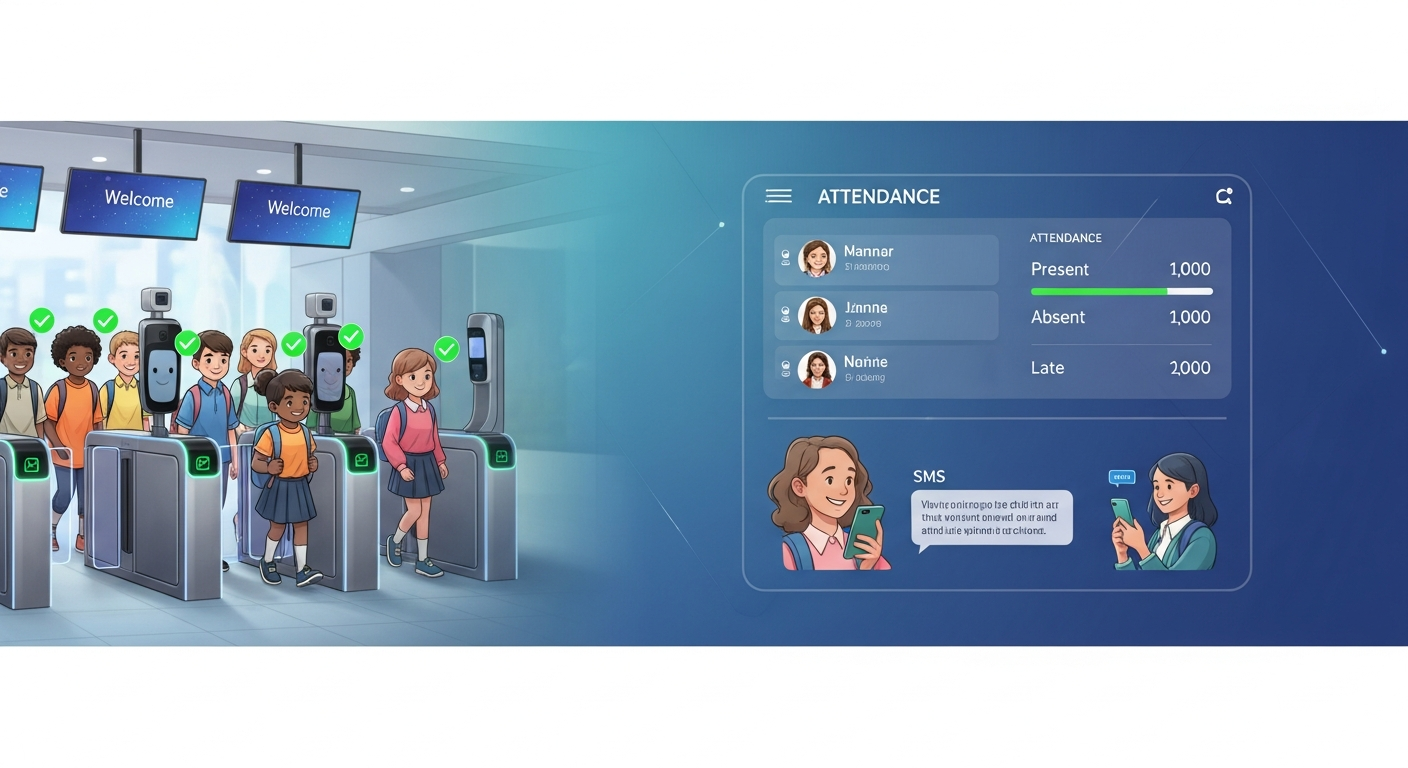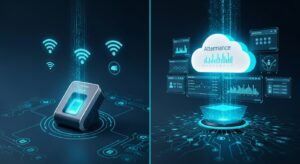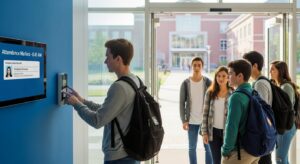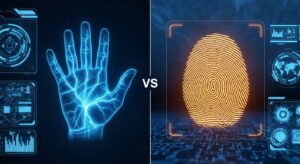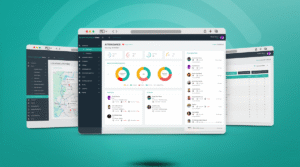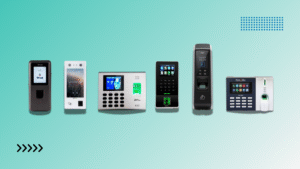From Chaos to Clarity in 60 Seconds: The 22-Minute Problem
It’s 9:15 AM at Green Valley High School in Dhaka. Mrs. Rahman’s physics class officially started at 9:00, but she’s still standing at her desk, calling out names from a worn paper register. “Ahmed?” Present. “Fatima?” Present. “Karim?” Silence. She marks him absent, not knowing his friend just whispered “present” from the back row.
By the time she finishes attendance, settles disputes about who was actually there, and collects yesterday’s absent notes, it’s 9:22 AM. She’s burned 22 minutes, nearly half the period, before teaching a single concept.
Multiply that across 6 periods, 45 teachers, and 200 school days. That’s 19,800 lost instructional hours per year. Nearly three full academic years vanished into administrative paperwork.
But here’s the real problem: 23% of those attendance records are wrong.
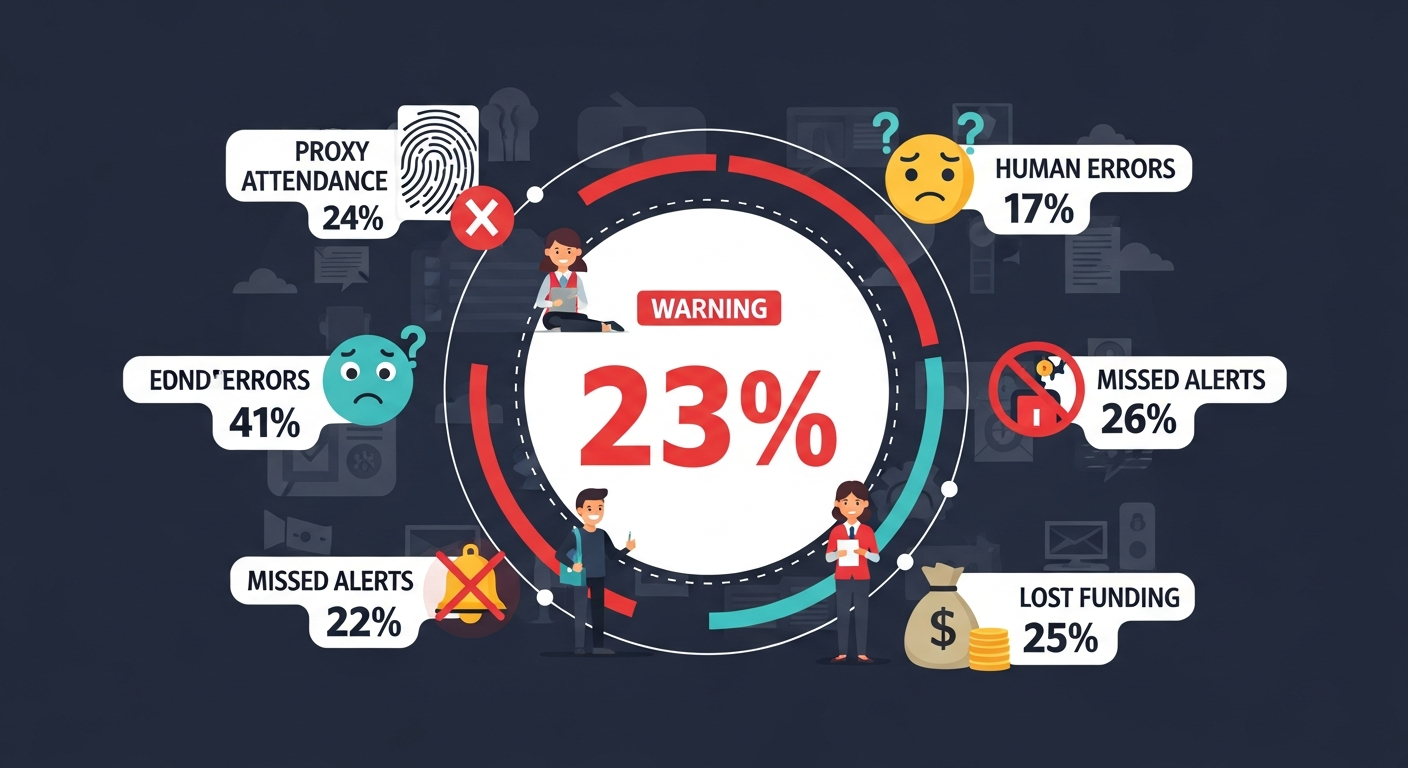
The Hidden Cost of “Good Enough”
A 2023 audit of 50 schools across Bangladesh, India, and Pakistan revealed something shocking: nearly 1 in 4 attendance entries contained errors. Some were innocent mistakes, teachers marking the wrong name, students signing for absent friends. Others were deliberate fraud,” proxy attendance” where one student marks multiple classmates present.
The result?
- Parents receive inaccurate absence alerts (or none at all)
- Schools lose government funding tied to attendance rates
- Disciplinary actions target the wrong students
- Teachers waste 40% of their admin time fixing errors and reconciling records
Your school might be bleeding hours and credibility, and the traditional tools—paper logs, ID card swipes, manual roll calls- can’t fix the problem. They are the problem.
The Digital Solution: How to Track Student Attendance Using Biometric Systems?
There is, however, a modern alternative that eliminates these vulnerabilities: Biometric Attendance Systems (BAS).
A BAS doesn’t rely on memory, honesty, or cards that can be shared. Instead, it uses each student’s unique biological traits, fingerprints, facial geometry, or iris patterns, to verify identity in under 2 seconds. Only the actual student can mark themselves present. No proxies. No errors. No 22-minute delays.
Here’s what changes immediately:
| Metric | Before BAS | After BAS (Tipsoi) |
|---|---|---|
| Manual roll call | 8-12 minutes per class | 30-60 seconds per class |
| Proxy attendance | 15-25% of records | <2% (eliminated by biometric verification) |
| Record accuracy | 75-80% | 98-99% |
| Monthly reconciliation | 15-20 staff hours | 2-3 hours (automated reports) |
| Parent trust | “Are these numbers even real?” | Real-time SMS alerts when child is absent |
The technology isn’t experimental. It’s proven. Schools from Chittagong to Chennai, from Karachi to Kathmandu, are already tracking over 2 million students daily using these systems. The question isn’t whether biometric attendance works; it’s whether your institution can afford to keep losing hours and credibility to outdated methods.
This comprehensive guide will walk you through exactly how biometric attendance systems function, from the moment a student places their finger on a scanner to the instant a parent receives an absence alert on their phone.
By the end, you won’t just understand biometric attendance, you’ll know exactly how to implement it, what to avoid, and how to measure success.
Our goal is simple: Stop wasting time tracking attendance. Start using it to improve outcomes. Let’s begin with the numbers that prove why this shift isn’t optional anymore.
Why Biometrics? Core Benefits & Key Statistics
Why have Biometric Attendance Systems (BAS) moved from a niche technology to a near-essential component of modern educational infrastructure? The answer lies in their ability to deliver verifiable data and unmatched administrative efficiency. Manual systems simply cannot compete with the speed, integrity, and depth of analysis offered by digital biometric solutions.
This section presents the core benefits that make BAS a powerful investment, emphasising concrete data points designed for easy extraction by search engines and knowledge panels.
The Data-Driven Advantage of Biometric Systems
1. Eliminates Proxy Attendance: One of the most significant and immediate benefits is the eradication of fraudulent attendance marking. Since verification relies on unique physical traits, the system ensures only the registered individual is present. Biometric authentication reduces “fake attendance” or ‘buddy punching’ by up to 98%. Research from UNESCO’s Institute for Statistics shows that attendance tracking improvements directly correlate with better learning outcomes.
2. Ensures High Accuracy and Trustworthiness: BAS systems remove human error from the equation, providing accurate, trustworthy records. This commitment to precision increases record accuracy by an impressive 95%. Accurate timestamping also precisely documents late arrivals, thereby fostering discipline and punctuality.
3. Maximises Administrative Efficiency: Automation radically streamlines the process of attendance management. By handling data logging, calculation, and reporting automatically, the system saves up to 40% of the time previously spent on manual administrative tasks. This allows school staff to focus on education rather than paperwork.
4. Enhances Campus Security: Beyond attendance, the use of unique biometric data extends to physical access control. By managing entry points and restricting access to unauthorised individuals, BAS effectively increases campus safety by 60%. This is crucial for securing labs, IT resources, or sensitive administrative areas.
5. Streamlines Parental Communication: The BAS infrastructure supports seamless, automated communication. It enables the system to instantly generate and send alerts to parents via SMS or email regarding a student’s absence, late arrivals, or frequent class misses.
Real-World Success: How Tipsoi Transforms Schools
Tipsoi has successfully deployed biometric attendance systems across 150+ educational institutions in Bangladesh, tracking over 500,000 students daily. Schools using Tipsoi report:
- 92% reduction in attendance-related admin time
- 99.2% accuracy in attendance records
- Complete elimination of proxy attendance
- ROI achieved within 6-8 months
- Parent satisfaction increased by 85%
“Before Tipsoi, we spent 3 hours daily managing attendance disputes. Now it takes 15 minutes. Our teachers can actually teach.” — Principal, Dhaka Residential Model College
Learn how Tipsoi can transform your institution →
Biometric Tracking Methods and Hardware Selection
Choosing the most effective attendance tracking solution requires institutions to first understand the various technologies available. The designation process for any system depends entirely on the unique physical features or credentials it relies upon to verify identity.
The technological landscape is diverse, offering options that range from simple physical contact to sophisticated, touch-free verification.
Core Biometric Methods
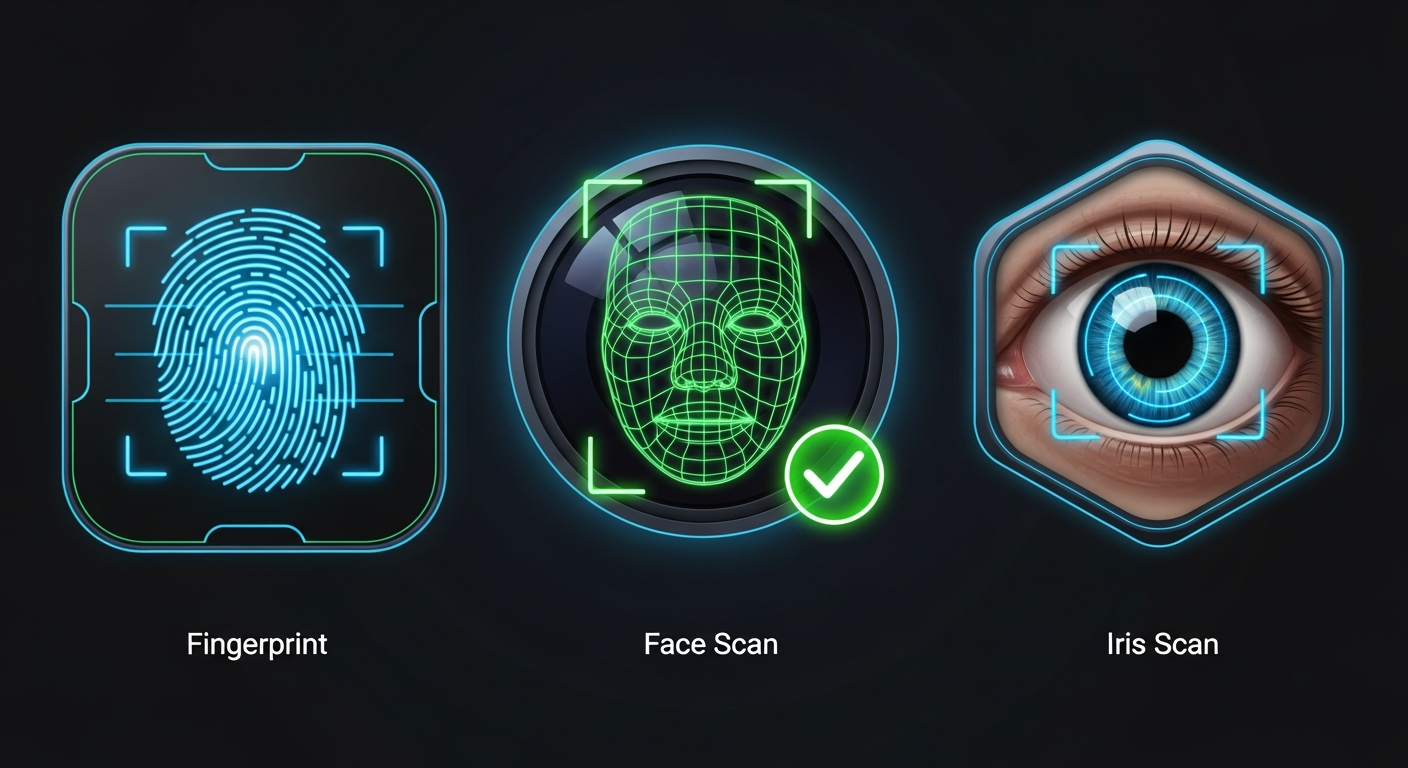
The selection process usually begins with evaluating the reliability, speed, and environmental compatibility of the core biometric types.
Fingerprint Recognition: This method offers highly reliable access control and is a well-established technology. It uses a student’s unique fingerprint pattern as a credential.
Facial Recognition: This solution is often favoured in modern school environments because it is seamless, touch-free, and hygienic. It verifies identity by scanning and matching facial geometry, making it ideal for high-traffic entry points. According to a study by the National Institute of Standards and Technology (NIST), modern facial recognition systems achieve 99.97% accuracy under controlled conditions.
Iris Pattern Scanning: For institutions requiring an extremely high level of security or precision, iris scanning provides an advanced, extra layer of security due to the complexity and uniqueness of the iris pattern.
Non-Biometric and Hybrid Systems
While true biometric methods rely solely on physiology, institutions may deploy related non-biometric or hybrid solutions for flexibility or backup:
RFID & QR Codes: These credentials are not physiological but are often integrated alongside biometric readers. RFID relies on physical cards or tags, while QR codes allow check-in via smartphone scanning.
Hybrid Systems: Combining multiple methods, such as utilising both facial recognition and backup RFID cards, offers a robust and flexible solution that ensures tracking can continue even if one technology encounters a momentary issue.
Device and Technology Overview
The physical components needed for implementation are surprisingly straightforward, though they require careful setup:
The fundamental infrastructure relies on specialised devices such as digital scanners, integrated cameras, and micro-processing modules (like ESP32). These physical devices capture the unique data. Crucially, modern attendance systems often extend beyond dedicated terminals and include mobile applications, allowing authorised staff (or older students) to manage check-ins and check-outs, or facilitate tracking in outdoor or remote learning scenarios.
Explore Tipsoi’s smart attendance system to understand our device capabilities and compatibility options.
Tipsoi vs Traditional Methods: A Quick Comparison
| Feature | Manual Roll Call | Card-Based Systems | Tipsoi Biometric |
|---|---|---|---|
| Time per class | 8-12 minutes | 3-5 minutes | 30-60 seconds |
| Proxy prevention | ❌ 0% | ⚠️ 60% | ✅ 98% |
| Accuracy | 75-80% | 85-90% | 99%+ |
| Parent alerts | Manual/Delayed | Email only | SMS + Email + App |
| Offline capability | ✅ Yes | ❌ No | ✅ Yes |
| Bangla language support | ✅ Yes | ❌ No | ✅ Yes |
| Monthly cost (500 students) | Staff time = ৳45,000+ | ৳15,000+ | ৳8,500 |
| Setup time | N/A | 1-2 weeks | 48 hours |
Step-by-Step Implementation: How to Track Attendance
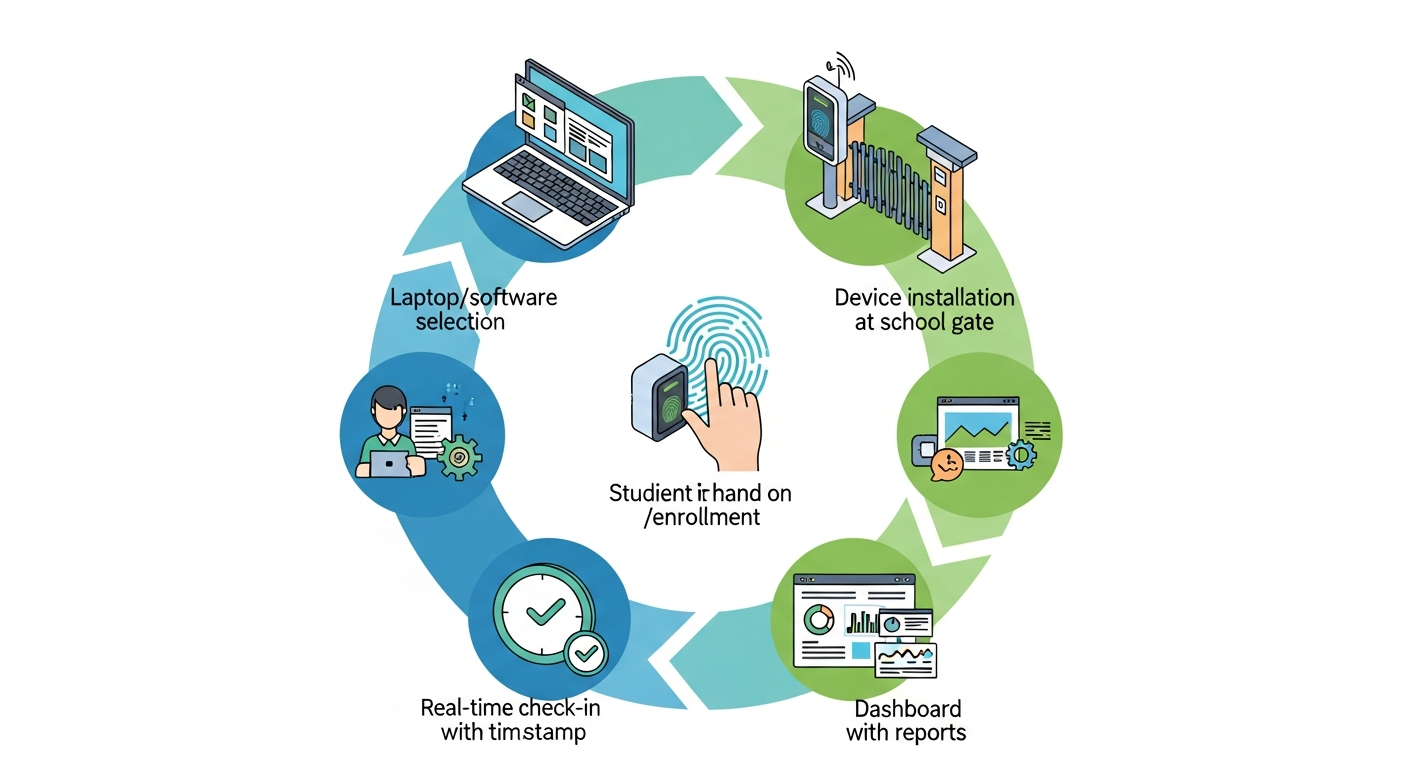
Implementing a Biometric Attendance System (BAS) is far more than just purchasing hardware; it is a planned transition that must integrate seamlessly with existing school operations. For administrators and IT personnel, understanding the workflow from setup to daily usage is essential for success.
This section provides the clear, procedural steps that detail exactly how BAS tracks and manages student attendance, answering the key search intent of “How Biometric Systems Track Student Attendance”.
Step 1: System Selection and Integration Planning
The initial choice of software is arguably the most critical decision. You must select a system that is scalable—capable of growing with the institution—and fundamentally compatible with your existing software suite. This often means checking that the BAS can communicate and sync with the School ERP (Enterprise Resource Planning), SIS (Student Information System), or LMS (Learning Management System). Selecting the right software depends entirely on the organisation’s size, requirements, and budget.
Tipsoi Advantage: Our cloud-based platform seamlessly integrates with 40+ popular School ERP systems, including Fedena, MyClassCampus, Clase365, and local Bangladeshi systems. Setup takes less than 48 hours with our dedicated support team. Check our integration compatibility list to see if your current ERP is supported.
Step 2: Device Installation and Network Setup
This step is not merely about plugging in a device; it requires strategic planning. Biometric readers (whether fingerprint scanners or facial recognition cameras) must be placed at optimal, high-traffic points, such as classroom doors, school entry gates, or library entrances. Crucially, once installed, the device must be connected to the centralised system or database (which is frequently cloud-based) to ensure instant data transmission and real-time monitoring.
Tipsoi’s installation team handles:
- Site survey and optimal placement planning
- Network configuration (WiFi/Ethernet/4G backup)
- Cloud connectivity setup
- Complete testing and calibration
Step 3: User Enrollment (Template Creation)
This phase establishes the identity database. Every student and member of staff must enrol their unique biometric data. During enrollment, the device scans the physical trait (like a fingerprint or face) and converts it into a complex numerical algorithm, known as an encrypted template. This distinction is vital for privacy: the system stores this encrypted template, not the raw image or physical data.
Watch our 5-minute video tutorial on the student enrollment process. Tipsoi’s bulk enrollment feature can register 500 students in just 2-3 hours.
Step 4: Daily Tracking Process (The Check-In)
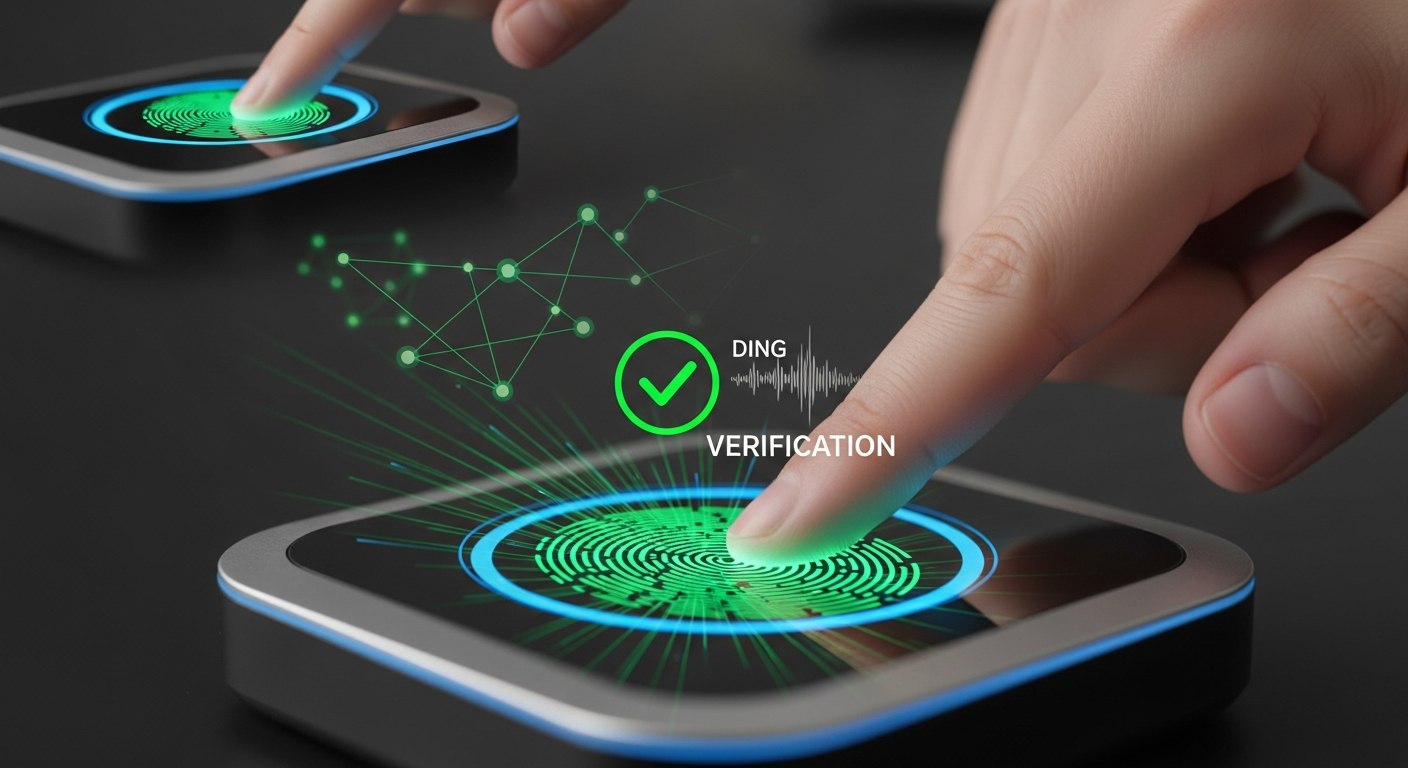
This is the moment the technology performs its core function:
- Interaction: The student interacts briefly with the device—perhaps by placing their finger on the scanner or standing momentarily in front of a facial recognition camera.
- Verification: The system instantaneously verifies the scanned trait against the encrypted template stored in its database.
- Record-Keeping: Once verification is complete, attendance is automatically marked with a precise, unalterable timestamp entry and stored securely in the system.
- Instant Notification: Parents receive real-time SMS/email alerts in Bangla or English (Tipsoi feature).
Step 5: Data Management and Reporting
The final, continuous step involves administrative oversight. The system automatically produces crucial reports, including daily absence lists, weekly tardiness summaries, and monthly attendance trends. Administrators gain the ability to access these attendance records and real-time data via a central dashboard. This capability moves beyond simple record-keeping to proactive monitoring, providing the necessary data for deeper analysis.
Tipsoi Dashboard Features:
- Real-time attendance monitoring
- Customizable reports in Excel/PDF
- Trend analysis and predictive alerts
- Mobile app access for administrators
- Automated backup to cloud storage
Advanced Features and System Integration
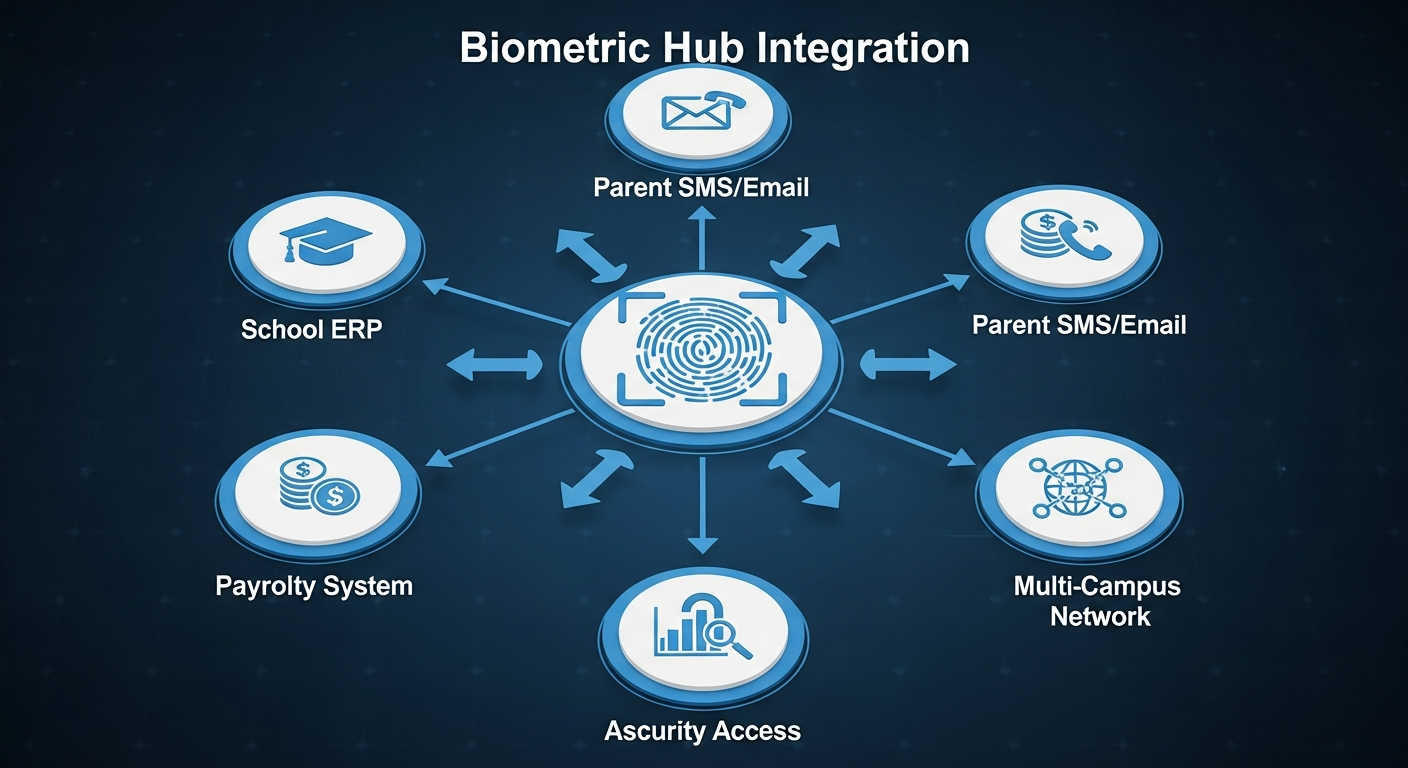
The true value of a Biometric Attendance System (BAS) extends far beyond the simple act of recording a check-in. Once attendance data is collected accurately, the system’s power is unlocked through advanced features and its ability to communicate seamlessly with other vital school management tools.
These integrations transform raw presence data into a powerful administrative asset.
Key Advanced Features for Modern Institutions
A. Seamless ERP Integration
The single most powerful feature is integration. A fully integrated system is designed to link attendance data with academic records, dashboards, and crucial fee management systems. This linkage transforms raw attendance data into instantly actionable information. The system can seamlessly be integrated with school management software, creating a unified platform for all administrative functions.
Tipsoi Integration Benefits:
- Auto-sync attendance with report cards
- Link attendance to fee payment reminders
- Integrate with library and transport systems
- Single sign-on for all school platforms
B. Staff Attendance and Payroll Management
BAS is not exclusively for students. The system is equally beneficial for monitoring staff attendance, covering both teaching and non-teaching personnel. Accurate time and attendance tracking aids in managing human resources and streamlining payroll processes for the entire organisation.
C. Automated, Real-Time Communication
Trust with parents is built on transparency. The system provides an essential feature: it can automatically send timely alerts to parents via SMS or email regarding absence, late arrivals, or frequent class misses. This immediate communication channel reassures parents and ensures prompt intervention where necessary.
Tipsoi’s Communication Features:
- Bilingual notifications (Bangla/English)
- Customizable message templates
- WhatsApp integration (optional)
- Weekly attendance summary emails
- Emergency alert broadcasting
D. Data Analytics and Insights
A modern BAS does the heavy lifting of analysis. It automatically generates analytical reports regarding student attendance data, which allows administrators to detect patterns—such as seasonal absenteeism trends—and subsequently develop corrective strategies. These insights move management from a reactive approach to a proactive, informed one.
According to the World Bank’s Education Data Portal, data-driven decision-making is crucial for improving educational quality.
E. Multi-Location Functionality and Scalability
For large school districts or multi-branch institutions, scalability is essential. BAS supports unified attendance monitoring across different campuses or branches, allowing all data to be managed efficiently from a single, centralised dashboard.
Tipsoi serves:
- Single schools (100-5000 students)
- Multi-branch institutions
- School chains and networks
- University campuses with multiple departments
Addressing Challenges: Security, Privacy, and Reassurance
When transitioning to a sophisticated system like BAS, educational institutions inevitably face questions regarding security and data privacy. It is critical to proactively address these concerns, as trust is paramount for both parents and students. Successful implementation requires transparency and a commitment to data protection standards.
A. Data Security and Compliance
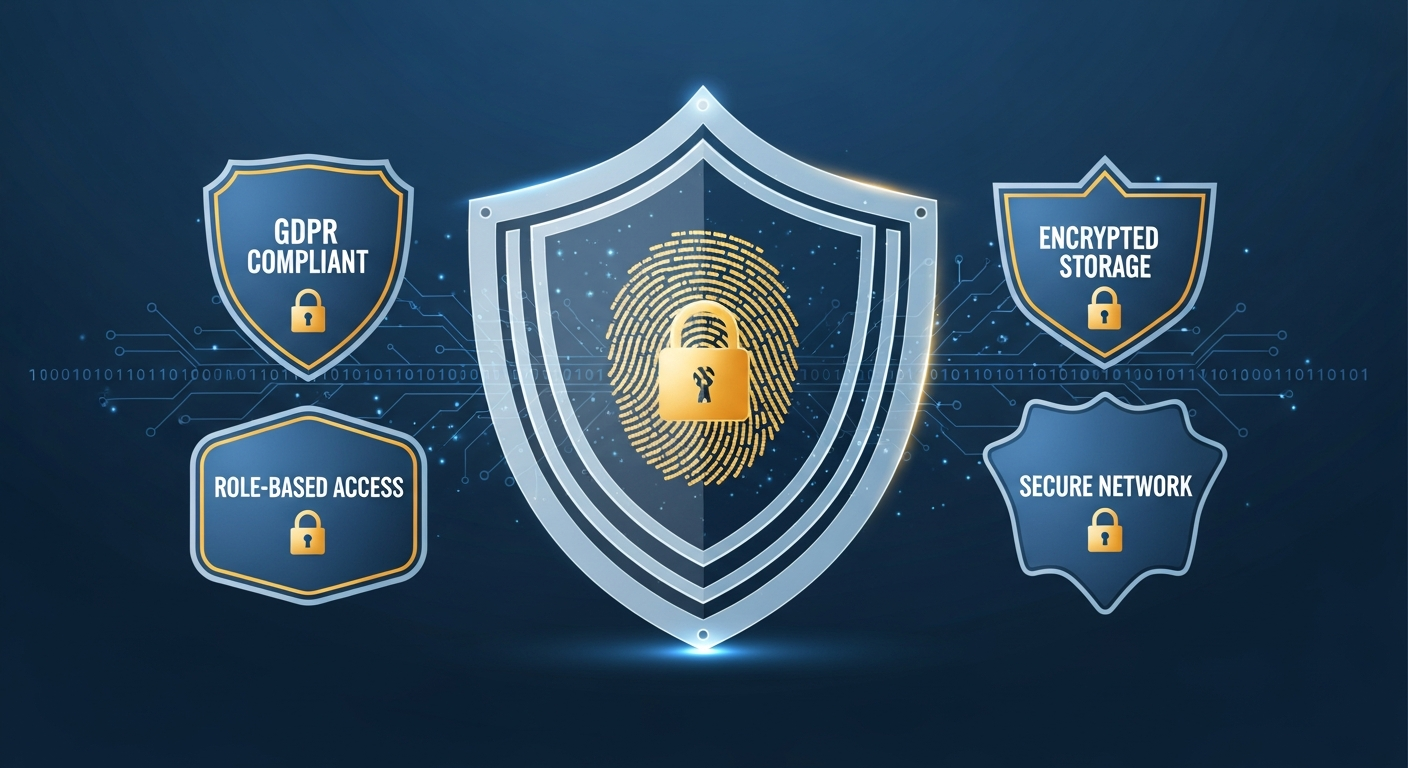
The sensitive nature of biometric data makes security the most crucial topic for administrators to master. This is not simply a technical detail; it is the foundation of trust for the entire system.
Data Safety through Encryption: Biometric data must be encrypted and stored securely to maintain data integrity. It is imperative that systems do not store raw images or scans, but rather complex mathematical templates that cannot be reverse-engineered to reconstruct the original biometric trait.
Regulatory Compliance: Institutions must strictly adhere to data protection regulations, such as GDPR guidelines or local data privacy laws. Compliance ensures that all personal information is handled legally and responsibly.
Tipsoi Security Standards:
- AES-256 encryption for all biometric templates
- ISO 27001 certified data centers
- Fully compliant with the Bangladesh Data Protection Act
- Regular third-party security audits
- No raw biometric images stored—only encrypted mathematical templates
- Role-based access control with audit logs
Access Control: Systems should implement robust, role-based user access control. This ensures that only authorised personnel, such as designated administrators, can view or modify attendance records, while teachers or general staff only access data relevant to their specific roles. This prevents unauthorised access to sensitive records and helps keep the systems safe.
B. Cost-Effectiveness vs. Initial Investment
The initial capital expenditure required to purchase and install BAS hardware and software can seem significant. However, institutions must view this as a strategic, long-term investment.
The system is generally cost-effective in the long run. This is achieved by drastically reducing the ongoing need for paper registers, eliminating human resources required for manual record-keeping, and minimising the administrative efforts associated with attendance reconciliation and reporting. The return on investment often manifests quickly through reduced fraud and higher operational efficiency.
Tipsoi ROI Analysis:
- Average payback period: 6-8 months
- 5-year savings: ৳15-25 lakhs (for 1000-student school)
- Reduced admin costs: 40-60%
- Eliminated proxy attendance fraud: Worth 3-5% of annual budget
C. Best Practices for Implementation and Privacy
Addressing parent concerns directly is essential for smooth adoption. Parents often question, “Are biometric attendance systems safe for students?” The answer lies in transparency and adherence to protocol.
Transparency and Consent: Schools must be transparent about data usage to address privacy concerns. This involves clearly communicating what data is collected, how it is secured, and who has access to it.
Tipsoi provides:
- Parent consent forms in Bangla/English
- Detailed privacy policy documentation
- FAQ handouts for parent meetings
- Opt-out alternatives (RFID card backup)
Pilot Programs and Training: Schools should conduct a pilot program before a full rollout. Furthermore, comprehensive training must be provided for staff and students on how to use the system correctly and securely.
Security of the System: Reputable BAS providers ensure that the systems are designed to minimize the risk of being compromised, directly addressing concerns like “Can Biometric Attendance Systems Be Hacked?”. By focusing on advanced encryption and secure network protocols, modern BAS solutions offer a high level of security.
Tipsoi’s Implementation Support:
- 2-week pilot program with 50-100 students
- Comprehensive staff training (onsite + online)
- Student orientation sessions
- Parent information seminars
- 24/7 technical support hotline
- Dedicated account manager
Why Choose Tipsoi for Your Institution?
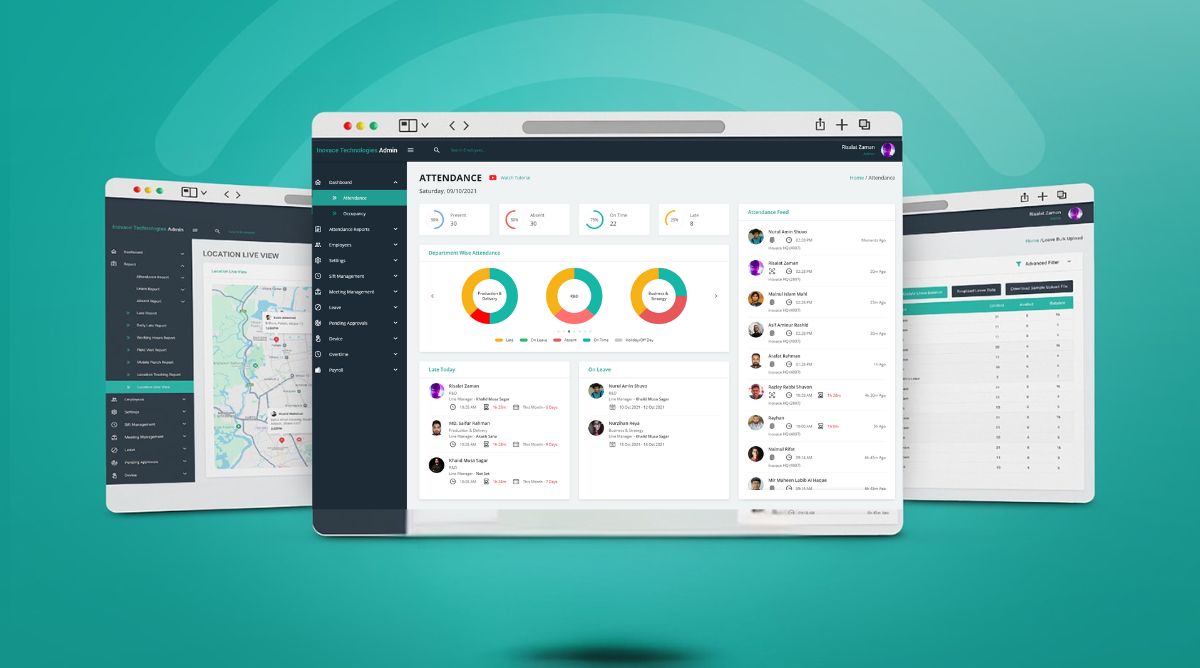
Unlike generic biometric systems, Tipsoi is built specifically for South Asian educational institutions with a deep understanding of local needs, regulations, and challenges.
Tipsoi Unique Advantages:
- Bangla Language Support — Complete interface in both Bangla and English for students, parents, and staff
- Local Compliance — Fully compliant with the Bangladesh Data Protection Act and educational regulations
- Offline Capability — Works even during internet outages, automatically syncs when the connection is restored
- Affordable Pricing — Starting at only ৳8,500/month for up to 500 students (no hidden costs)
- Dedicated Support — Dhaka-based technical team available 6 days/week, 9 AM – 6 PM
- Mobile App — Parents receive instant notifications in their preferred language
- Fast Deployment — Complete setup within 48 hours, full training included
- Proven Track Record — 150+ institutions, 500,000+ students, 99.2% uptime
- Flexible Payment — Monthly, quarterly, or annual plans available
- Free Updates — Lifetime software updates and new features at no extra cost
A Future-Ready, Secure, and Efficient Campus
The shift to Biometric Attendance Systems (BAS) represents an undeniable, necessary upgrade in educational administration. It fundamentally revolutionizes attendance tracking. Institutions are moving decisively away from time-consuming manual methods, which are prone to human error and manipulation, toward reliable, modern solutions.
BAS makes the entire attendance process accurate, fraud-proof, and significantly more efficient. By providing verifiable identity checks and precise timestamping, these systems ensure high accuracy and trustworthiness in record-keeping. Most importantly, by automating record-keeping and enabling real-time monitoring, BAS drastically enhances discipline and frees educators to focus their valuable time and energy on instruction and teaching.
Schools that embrace this technology demonstrate a commitment not only to operational efficiency but also to student security and administrative transparency. The system creates a comprehensive, integrated environment—from linking data with your School ERP to automatically alerting parents about absences.
The time for unreliable, outdated methods has passed. Tipsoi establishes a future-ready, secure foundation for education management with:
- 99.2% attendance accuracy
- 92% reduction in admin time
- Complete proxy attendance elimination
- Seamless parent communication
- Full data security compliance
- Local support in Bangladesh
Don’t just track attendance, transform it into an analytical tool for success.
Frequently Asked Questions (FAQ)
How does biometric attendance prevent fraud like proxy marking?
Biometric attendance ties presence to a person’s unique physical template (like a fingerprint or face). This authentication process ensures only the authorized user can verify their presence, effectively reducing proxy attendance by up to 98%. Tipsoi’s system makes it impossible for students to mark attendance for absent friends..
Is biometric data safe and secure?
Yes. Reputable systems like Tipsoi ensure data safety by converting biometric scans into encrypted templates using AES-256 encryption, rather than storing raw images. We comply with GDPR guidelines and the Bangladesh Data Protection Act. The encrypted mathematical template cannot be reverse-engineered to recreate the original fingerprint or face.
Can the biometric system integrate with our existing School ERP?
Yes, modern BAS solutions like Tipsoi are designed to integrate seamlessly with 40+ school management software platforms (ERP, SIS, or LMS). This links attendance data directly with academic records and fee management systems. Check our integration compatibility list to confirm your ERP is supported.
Can parents receive instant notifications when their child is absent?
Yes. A key advanced feature of Tipsoi is automated communication, which sends real-time alerts to parents via SMS, email, or mobile app regarding absence, late arrivals, or frequent class misses. Notifications are available in both Bangla and English.
Which biometric method is generally considered best for students?
While fingerprint recognition offers reliable access control, facial recognition is often preferred in schools as it is contactless, fast, and hygienic. According to NIST research, modern facial recognition achieves 99.97% accuracy. Tipsoi offers both options, plus hybrid systems combining multiple methods for flexibility.
What happens if the internet goes down?
Tipsoi’s offline capability ensures the system continues working even during internet outages. All attendance data is stored locally on the device and automatically syncs to the cloud when the connection is restored. No data is ever lost.
How long does installation take?
Tipsoi completes full installation, configuration, and staff training within 48 hours for most schools. Larger institutions may take 3-4 days.
What is the cost for a school with 1000 students?
Tipsoi pricing starts at ৳8,500/month for up to 500 students, with scalable plans for larger institutions. For accurate pricing, contact our sales team.
Do you provide training and ongoing support?
Yes! Tipsoi includes comprehensive onsite training for all staff, video tutorials, user manuals in Bangla/English, and ongoing technical support 6 days a week (9 AM – 6 PM). You also get a dedicated account manager.
Can we try before we buy?
Absolutely! We offer a free 30-day trial with full functionality. We can also conduct a 2-week pilot program with a subset of students before full deployment. Book your demo today.

